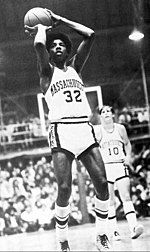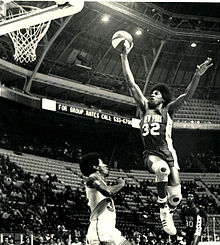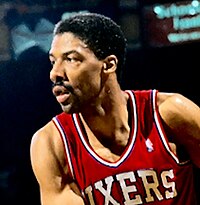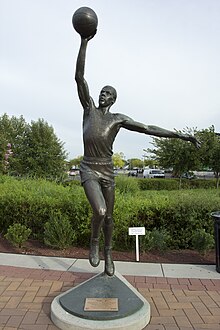Julius Erving
Julius Winfield Erving II (born February 22, 1950), commonly known by the nickname Dr. J, is an American former professional basketball player.
In both 1996 and 2021, Erving was again honored as one of the league's greatest players of all time by being named to the NBA's 50th[2] and 75th anniversary teams, respectively.
[4] His signature was the slam dunk, since incorporated into the vernacular and basic skill set of the game in the same manner as the crossover dribble and the no look pass.
[7] Erving was born February 22, 1950, in East Meadow, on Long Island,[8][9][10] and raised from the age of 13 in Roosevelt, New York.
[18] Fifteen years later, Erving fulfilled a promise he had made to his mother by earning a bachelor's degree in creative leadership and administration from the school through the University Without Walls program.
[30] He discovered that his agent at the time, Steve Arnold, was employed by the Squires and convinced him to sign a below-market contract.
He played two exhibition games with the Hawks until NBA Commissioner J. Walter Kennedy ruled that the Bucks owned Erving's rights via the draft.
The Nets and Nuggets had applied for admission to the NBA before the season, in anticipation of the eventual merger that had first been proposed by the two leagues in 1970 but which was delayed for various reasons, including the Oscar Robertson free agency suit (which was not resolved until 1976).
With Erving and Nate Archibald (acquired in a trade with Kansas City), the Nets were poised to pick up right where they left off.
Coming on the heels of the fees the Nets had to pay for joining the NBA, owner Roy Boe reneged on a promise to raise Erving's salary.
[43] The Sixers then decided to offer to buy Erving's contract for $3 million—in addition to paying roughly the Nets same amount as their expansion fee—and Boe had little choice but to accept the $6 million deal.
[47] Erving enjoyed success off the court, becoming one of the first basketball players to endorse many products and to have a shoe marketed under his name.
Eventually, coach Billy Cunningham and top-level players like Maurice Cheeks, Andrew Toney, and Bobby Jones were added to the mix and the franchise was very successful.
In 1979, Larry Bird entered the league, reviving the Boston Celtics and the storied Celtics–76ers rivalry; these two teams faced each other in the Eastern Conference Finals in 1980, 1981, 1982 and 1985.
[49] For the 1982–1983 season, the Sixers obtained the missing element to combat their weakness at their center position, Moses Malone.
[50] In fact, the Sixers went four-five-four, losing one game to the Milwaukee Bucks in the conference finals, then sweeping the Lakers to win the NBA title.
Erving maintained his all-star caliber of play into his twilight years, averaging 22.4, 20.0, 18.1 and 16.8 points per game in his final seasons.
That final season saw opposing teams pay tribute to Erving in the last game he would play in their arenas, including in cities such as Boston and Los Angeles, his perennial rivals in the playoffs.
Johnny Kerr told ABA historian Terry Pluto: "A young Julius Erving was like Thomas Edison, he was always inventing something new every night."
As of 2022[update], Erving ranks eighth on the list, behind only LeBron James, Kareem Abdul-Jabbar, Karl Malone, Kobe Bryant, Michael Jordan, Dirk Nowitzki and Wilt Chamberlain.
In this memorable contest, Erving faced George "The Iceman" Gervin, All-Star and former teammate Larry "Special K" Kenon, MVP Artis "The A-Train" Gilmore and David "The Skywalker" Thompson.
After Portland scored a basket, Erving immediately ran the length of the court with the entire Blazers team defending him.
[55][56][57] After his basketball career ended, he became a businessman, obtaining ownership of a Coca-Cola bottling plant in Philadelphia and doing work as a television analyst.
[citation needed] He has also served on the Board of Directors of Converse (prior to their 2001 bankruptcy), Darden Restaurants, Saks Incorporated and The Sports Authority.
Erving made a cameo appearance in the 1993 movie Philadelphia starring Tom Hanks and Denzel Washington and in the sitcom Hangin' with Mr. Cooper in 1995.
[72][73] On September 10, 2021, Erving attended an unveiling ceremony at the University of Massachusetts Amherst for statues honoring himself and fellow UMass alumni and Basketball Hall of Fame members John Calipari, Marcus Camby and Jack Leaman.
The ceremony was attended by former teammates, coaches, family and current players of the UMass men's and women's basketball teams.
Twitchell was known for his portraits and he lobbied to paint basketball great Julius Erving in a business suit instead of a uniform to portray him more as a man and role model than simply another well-known athlete.
The cloth's smooth surface allowed Twitchell to craft Erving with uncannily realistic detail, from the crease in his tan suit trousers to the gold bracelet on his right hand.
Local residents, who maintain a small park in front of the mural, claim that the real Dr. J had tears in his eyes when he saw the completed portrait for the first time.







